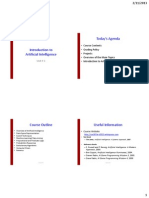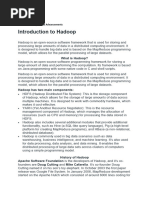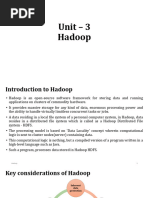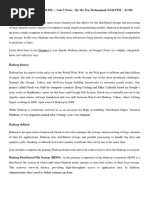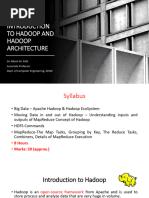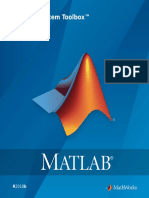0 ratings0% found this document useful (0 votes)
7 viewsU1-Lec 4
U1-Lec 4
Uploaded by
Papu KuttyThe document is a lecture on introducing Apache Hadoop. It discusses that Hadoop is an open-source software framework used for storing and processing large datasets in a distributed computing environment. Hadoop has two main components - HDFS for storage and YARN for resource management. It also includes additional modules like Hive, Pig, and HBase that provide further functionality. Some key features of Hadoop are that it is fault tolerant, highly available, has easy programming and huge flexible storage at low cost.
Copyright:
© All Rights Reserved
Available Formats
Download as PPTX, PDF, TXT or read online from Scribd
U1-Lec 4
U1-Lec 4
Uploaded by
Papu Kutty0 ratings0% found this document useful (0 votes)
7 views12 pagesThe document is a lecture on introducing Apache Hadoop. It discusses that Hadoop is an open-source software framework used for storing and processing large datasets in a distributed computing environment. Hadoop has two main components - HDFS for storage and YARN for resource management. It also includes additional modules like Hive, Pig, and HBase that provide further functionality. Some key features of Hadoop are that it is fault tolerant, highly available, has easy programming and huge flexible storage at low cost.
Copyright
© © All Rights Reserved
Available Formats
PPTX, PDF, TXT or read online from Scribd
Share this document
Did you find this document useful?
Is this content inappropriate?
The document is a lecture on introducing Apache Hadoop. It discusses that Hadoop is an open-source software framework used for storing and processing large datasets in a distributed computing environment. Hadoop has two main components - HDFS for storage and YARN for resource management. It also includes additional modules like Hive, Pig, and HBase that provide further functionality. Some key features of Hadoop are that it is fault tolerant, highly available, has easy programming and huge flexible storage at low cost.
Copyright:
© All Rights Reserved
Available Formats
Download as PPTX, PDF, TXT or read online from Scribd
Download as pptx, pdf, or txt
0 ratings0% found this document useful (0 votes)
7 views12 pagesU1-Lec 4
U1-Lec 4
Uploaded by
Papu KuttyThe document is a lecture on introducing Apache Hadoop. It discusses that Hadoop is an open-source software framework used for storing and processing large datasets in a distributed computing environment. Hadoop has two main components - HDFS for storage and YARN for resource management. It also includes additional modules like Hive, Pig, and HBase that provide further functionality. Some key features of Hadoop are that it is fault tolerant, highly available, has easy programming and huge flexible storage at low cost.
Copyright:
© All Rights Reserved
Available Formats
Download as PPTX, PDF, TXT or read online from Scribd
Download as pptx, pdf, or txt
You are on page 1of 12
BIG DATA
UNIT 1
Lecture 4
Introducing Apache Hadoop
Prepared By
Mrs.J.Gokulapriya
Assistant Professor- CS
Department of Computer Science
Rathinam College of Arts and Science
22MCS3CB- Big Data Analytics - Lecture 4 | Page 1
INTRODUCTION
• Apache Software Foundation is the developers of
Hadoop, and it’s co-founders are Doug
Cutting and Mike Cafarella. It’s co-founder Doug
Cutting named it on his son’s toy elephant. In
October 2003 the first paper release was Google File
System. In January 2006, MapReduce development
started on the Apache Nutch which consisted of
around 6000 lines coding for it and around 5000 lines
coding for HDFS. In April 2006 Hadoop 0.1.0 was
released.
22MCS3CB- Big Data Analytics - Lecture 4
| Page 2
• What is Hadoop?
• Hadoop is an open source software programming
framework for storing a large amount of data and
performing the computation. Its framework is based
on Java programming with some native code in C and
shell scripts.
• Hadoop is an open-source software framework that is
used for storing and processing large amounts of data
in a distributed computing environment. It is
designed to handle big data and is based on the
MapReduce programming model, which allows for
the parallel processing of large datasets.
22MCS3CB- Big Data Analytics - Lecture 4
| Page 3
• Hadoop has two main components:
• HDFS (Hadoop Distributed File System): This is the
storage component of Hadoop, which allows for the
storage of large amounts of data across multiple
machines. It is designed to work with commodity
hardware, which makes it cost-effective.
• YARN (Yet Another Resource Negotiator): This is the
resource management component of Hadoop, which
manages the allocation of resources (such as CPU and
memory) for processing the data stored in HDFS.
22MCS3CB- Big Data Analytics - Lecture 4
| Page 4
• Hadoop also includes several additional modules that
provide additional functionality, such as Hive (a
SQL-like query language), Pig (a high-level platform
for creating MapReduce programs), and HBase (a
non-relational, distributed database).
• Hadoop is commonly used in big data scenarios such
as data warehousing, business intelligence, and
machine learning. It’s also used for data processing,
data analysis, and data mining. It enables the
distributed processing of large data sets across
clusters of computers using a simple programming
model.
22MCS3CB- Big Data Analytics - Lecture 4
| Page 5
• Features of hadoop:
• 1. it is fault tolerance.
• 2. it is highly available.
• 3. it’s programming is easy.
• 4. it have huge flexible storage.
• 5. it is low cost.
22MCS3CB- Big Data Analytics - Lecture 4
| Page 6
Hadoop Distributed File System
22MCS3CB- Big Data Analytics - Lecture 4
| Page 7
• Advantages of HDFS: It is inexpensive, immutable
in nature, stores data reliably, ability to tolerate faults,
scalable, block structured, can process a large amount
of data simultaneously and many more.
• Disadvantages of HDFS: It’s the biggest
disadvantage is that it is not fit for small quantities of
data. Also, it has issues related to potential stability,
restrictive and rough in nature. Hadoop also supports
a wide range of software packages such as Apache
Flumes, Apache Oozie, Apache HBase, Apache
Sqoop, Apache Spark, Apache Storm, Apache Pig,
Apache Hive, Apache Phoenix, Cloudera Impala.
22MCS3CB- Big Data Analytics - Lecture 4
| Page 8
• Hadoop framework is made up of the following
modules:
• Hadoop MapReduce- a MapReduce programming
model for handling and processing large data.
• Hadoop Distributed File System- distributed files in
clusters among nodes.
• Hadoop YARN- a platform which manages
computing resources.
• Hadoop Common- it contains packages and libraries
which are used for other modules.
22MCS3CB- Big Data Analytics - Lecture 4
| Page 9
• Advantages:
• Ability to store a large amount of data.
• High flexibility.
• Cost effective.
• High computational power.
• Tasks are independent.
• Linear scaling.
22MCS3CB- Big Data Analytics - Lecture 4
| Page 10
• Disadvantages:
• Not very effective for small data.
• Hard cluster management.
• Has stability issues.
• Security concerns.
22MCS3CB- Big Data Analytics - Lecture 4
| Page 11
Thank You
22MCS3CB- Big Data Analytics - Lecture 4
| Page 12
You might also like
- Master Data Management (MDM) Sales Assessment For ReSellersDocument37 pagesMaster Data Management (MDM) Sales Assessment For ReSellersashis0% (1)
- Introduction To AI Unit 1Document10 pagesIntroduction To AI Unit 1Abdun Nafay QureshiNo ratings yet
- Mind Design IIDocument8 pagesMind Design IIBoudzi_Boudzo_52640% (1)
- Big Data Unit IIDocument42 pagesBig Data Unit IIReddy SrihemanthNo ratings yet
- UNIT-I Introduction To Hadoop - A20Document24 pagesUNIT-I Introduction To Hadoop - A20Manoj ReddyNo ratings yet
- HadoopDocument13 pagesHadoopkajole7693No ratings yet
- HADOOPDocument18 pagesHADOOPmaiyi020106No ratings yet
- Bda PPT M1 P2 1Document19 pagesBda PPT M1 P2 1JvNo ratings yet
- HADOOPDocument10 pagesHADOOPdebasmita.sahaNo ratings yet
- Seminar Umera HadoopDocument14 pagesSeminar Umera HadoopUmera RawootNo ratings yet
- Unit 3 ETI (BDA)Document34 pagesUnit 3 ETI (BDA)abdulahad.ubeidNo ratings yet
- Chapter 2Document19 pagesChapter 2lalisagutamaNo ratings yet
- CC Unit - 5Document27 pagesCC Unit - 5harshitamakhija100No ratings yet
- BDS-Session6.pptxDocument7 pagesBDS-Session6.pptxarihantlunkar1993No ratings yet
- DS Unit 4.1Document14 pagesDS Unit 4.1Tanmay MandalNo ratings yet
- Unit IiiDocument20 pagesUnit Iiisrinivas79668No ratings yet
- Seminar PPT on HadoopDocument13 pagesSeminar PPT on HadoopUmera RawootNo ratings yet
- 1 - Big Data and Hadoop FrameworkDocument40 pages1 - Big Data and Hadoop FrameworkPrishita KapoorNo ratings yet
- Big Data RAJNEESH CCCDocument11 pagesBig Data RAJNEESH CCCvidhya associateNo ratings yet
- Exploring Bigdata With Hadoop: Dr.A.Bazila Banu Associate Professor Department of CseDocument23 pagesExploring Bigdata With Hadoop: Dr.A.Bazila Banu Associate Professor Department of CseMAMAN MYTHIEN SNo ratings yet
- Big Data ABHISHEK PRAJA C CCCCCCCCCCCDocument11 pagesBig Data ABHISHEK PRAJA C CCCCCCCCCCCvidhya associateNo ratings yet
- Map ReduceDocument3 pagesMap ReducejefferyleclercNo ratings yet
- Unit-2 HadoopDocument16 pagesUnit-2 Hadoopabhaypratapverma6969No ratings yet
- Unit - 3Document34 pagesUnit - 3sixit37787No ratings yet
- Chapter 2 Hadoop Eco SystemDocument34 pagesChapter 2 Hadoop Eco Systemlamisaldhamri237No ratings yet
- Unit 2Document10 pagesUnit 2tripathineeharikaNo ratings yet
- Bda 18CS72 Mod-2Document152 pagesBda 18CS72 Mod-2Dhathri ReddyNo ratings yet
- module -1-Part IIDocument45 pagesmodule -1-Part IIJonti DeuriNo ratings yet
- Unit 2-1Document43 pagesUnit 2-1sahuakshat286No ratings yet
- Unit 2Document21 pagesUnit 2sisax91607No ratings yet
- Unit V Cloud Technologies and AdvancementsDocument33 pagesUnit V Cloud Technologies and AdvancementsspartansheikNo ratings yet
- Hadoop, A Distributed Framework For Big DataDocument55 pagesHadoop, A Distributed Framework For Big Datasonia choudharyNo ratings yet
- BDA Unit 2Document39 pagesBDA Unit 21DA20CS051JEEVANNo ratings yet
- HadoopDocument11 pagesHadoopInu KagNo ratings yet
- Bda Unit 4 MaterialDocument37 pagesBda Unit 4 MaterialSiva Saikumar Reddy KNo ratings yet
- Lecture 1Document55 pagesLecture 1George OkemwaNo ratings yet
- Unit 4 HadoopDocument31 pagesUnit 4 Hadoopazhagu sundariNo ratings yet
- Big Data Lab ManualDocument44 pagesBig Data Lab Manualamartya1820No ratings yet
- School of Computer Engineering: Kalinga Institute of Industrial Technology Deemed To Be University Bhubaneswar-751024Document260 pagesSchool of Computer Engineering: Kalinga Institute of Industrial Technology Deemed To Be University Bhubaneswar-75102421053386No ratings yet
- Poetic SeminarDocument17 pagesPoetic Seminarifizon williamNo ratings yet
- Hadoop and Their EcosystemDocument24 pagesHadoop and Their Ecosystemsunera pathan100% (2)
- Big Data Analytics Unit-3Document15 pagesBig Data Analytics Unit-34241 DAYANA SRI VARSHANo ratings yet
- Hadoop 101 - Sales Training - v4 - 4x3formatDocument29 pagesHadoop 101 - Sales Training - v4 - 4x3formatSNNo ratings yet
- Guided By:-Prof. K. Kakwani: Payal M. WadhwaniDocument24 pagesGuided By:-Prof. K. Kakwani: Payal M. WadhwaniRavi JoshiNo ratings yet
- Hadoop Chapter 1Document6 pagesHadoop Chapter 1SwatiNo ratings yet
- Big - Data - Analytics - Srii (2) - Read-OnlyDocument11 pagesBig - Data - Analytics - Srii (2) - Read-Onlydivyadharshni100No ratings yet
- Big Data 3rd ModuleDocument22 pagesBig Data 3rd ModuleSmitha RajeshNo ratings yet
- Big Data Analysis IAT-1Document43 pagesBig Data Analysis IAT-1mervismascarenhasNo ratings yet
- UNIT-IV -BDADocument150 pagesUNIT-IV -BDAmanikumargattu17No ratings yet
- BDA Unit 3Document6 pagesBDA Unit 3SpNo ratings yet
- Chapter 2 - 大数据生态系统Document31 pagesChapter 2 - 大数据生态系统gs68295No ratings yet
- Unit 3 - BD - Hadoop EcosystemDocument42 pagesUnit 3 - BD - Hadoop Ecosystem2028110No ratings yet
- Hadoop, A Distributed Framework For Big DataDocument55 pagesHadoop, A Distributed Framework For Big DataHARISH REDDY BNo ratings yet
- CC-KML051-Unit VDocument17 pagesCC-KML051-Unit VFdjsNo ratings yet
- Hadoop NotesforstudentsDocument13 pagesHadoop NotesforstudentsSaif FazalNo ratings yet
- Spark Streaming ResearchDocument6 pagesSpark Streaming Researchreshmashaik4656No ratings yet
- Unit 2Document30 pagesUnit 2Awadhesh MauryaNo ratings yet
- Introduction: Hadoop's History and Advantages 2. Architecture in Detail 3. Hadoop in IndustryDocument53 pagesIntroduction: Hadoop's History and Advantages 2. Architecture in Detail 3. Hadoop in Industryjainam dudeNo ratings yet
- Chapter2 BdiDocument101 pagesChapter2 BdiMahek UpadhyeNo ratings yet
- BD - HadoopEcoSystem Unit 2part 1Document12 pagesBD - HadoopEcoSystem Unit 2part 1Rameshwar KanadeNo ratings yet
- Parallel ProjectDocument32 pagesParallel Projecthafsabashir820No ratings yet
- Mastering Big Data and Hadoop: From Basics to Expert ProficiencyFrom EverandMastering Big Data and Hadoop: From Basics to Expert ProficiencyNo ratings yet
- Sentiment Analysis On TweetsDocument2 pagesSentiment Analysis On TweetsvikibytesNo ratings yet
- Li Model-Contrastive Federated Learning CVPR 2021 PaperDocument10 pagesLi Model-Contrastive Federated Learning CVPR 2021 PaperDr. V. Padmavathi Associate ProfessorNo ratings yet
- Alexander Riegler New Horizons For Secondorder Cybernetics 1Document379 pagesAlexander Riegler New Horizons For Secondorder Cybernetics 1orango quangoNo ratings yet
- CSA PresentationDocument70 pagesCSA PresentationAbd AzizNo ratings yet
- Practical Research 1 (Technology-Artificial Intelligence)Document3 pagesPractical Research 1 (Technology-Artificial Intelligence)Mark OrmegaNo ratings yet
- Perceptron - WikipediaDocument9 pagesPerceptron - WikipediaNoles PandeNo ratings yet
- Tarea 1 - Ejercicio 2.4xxDocument6 pagesTarea 1 - Ejercicio 2.4xxjoacocnNo ratings yet
- Artificial Neural Networks For Structural Damage Detection Using Modal DataDocument26 pagesArtificial Neural Networks For Structural Damage Detection Using Modal DataKiran HegdeNo ratings yet
- Fuzzy LogicDocument21 pagesFuzzy LogicArpit YadavNo ratings yet
- Functionalist StylisticsDocument34 pagesFunctionalist Stylisticsromamarianguadana3156% (9)
- How To Design Automatic Voltage Regulator (AVR) Model of ThermalHydro Power Plant Using Transfer Functions in MATLABSIMULINKDocument12 pagesHow To Design Automatic Voltage Regulator (AVR) Model of ThermalHydro Power Plant Using Transfer Functions in MATLABSIMULINKsengsouvanhphaysaly phaysalyNo ratings yet
- Voice Recognition and Voice Comparison Using Machine Learning Techniques: A SurveyDocument7 pagesVoice Recognition and Voice Comparison Using Machine Learning Techniques: A SurveyBrightworld ProjectsNo ratings yet
- The Functions of Deep Learning: Gilbert StrangDocument1 pageThe Functions of Deep Learning: Gilbert StrangGurpinder SinghNo ratings yet
- CS401 Computer Graphics PDFDocument3 pagesCS401 Computer Graphics PDFvonacoc49No ratings yet
- Motivations of Fuzzy LogicDocument3 pagesMotivations of Fuzzy Logicaleena_bcNo ratings yet
- BUSI 651 - Week 3nDocument24 pagesBUSI 651 - Week 3nFabian Enrique Acosta CortesNo ratings yet
- Estimate at CompletionDocument3 pagesEstimate at Completionc6nysf9jm6No ratings yet
- Unit: 1 Introduction To Artificial Intelligence and Machine LearningDocument17 pagesUnit: 1 Introduction To Artificial Intelligence and Machine LearningAdnankhanNo ratings yet
- ZAGATOWKADocument115 pagesZAGATOWKAAndrei BotezatuNo ratings yet
- Accenture AI Guide For ExecutivesDocument92 pagesAccenture AI Guide For ExecutivesRafael Novak100% (2)
- CEP 1 Employee Performance Mapping Problem StatementDocument4 pagesCEP 1 Employee Performance Mapping Problem StatementDania AlhrbiNo ratings yet
- Matlab Control System Toolbox User's Guide (PDFDrive)Document1,816 pagesMatlab Control System Toolbox User's Guide (PDFDrive)Fathi HarrathNo ratings yet
- Root Locus Design Method CafsanchezdiDocument12 pagesRoot Locus Design Method CafsanchezdiJuan Nicolas Carvajal BaronNo ratings yet
- Analysis of Rumour Detection Using Deep Learning Methods On Social MediaDocument10 pagesAnalysis of Rumour Detection Using Deep Learning Methods On Social MediaInternational Journal of Innovative Science and Research TechnologyNo ratings yet
- Basic and Advanced Regulatory Control - System Design and Application (2nd Edition)Document4 pagesBasic and Advanced Regulatory Control - System Design and Application (2nd Edition)siamak001No ratings yet
- Ai MockDocument5 pagesAi Mockmondalkakoli83No ratings yet
- Applying Machine Learning To Estimate The Effort and Duration of Individual Tasks in Software ProjectsDocument14 pagesApplying Machine Learning To Estimate The Effort and Duration of Individual Tasks in Software ProjectsRodrigo De Nadai GrigoletoNo ratings yet

